There’s no retirement home for this guy. No, he is now over 3000 years old and is still an active superhero. He is the “world’s weirdest action hero,” “the flexible man with the power of steel.”
He is Plastic Man. His superpower is flexibility: He can bend, twist, and morph into any shape. And through it all—the rubber band man never loses his sunglasses.
Plastic Man stretches every part of his body to capture criminals, save the day, and grab a soup can from the top shelf. Just like you. Or, you would, but you forgot what you came into the kitchen for in the first place.
As we age, we lose flexibility—we feel joints stiffen, we rise from chairs more slowly, and we stumble recalling names and factoids. We may even feel that we’re losing brain cells. The spring in our steps is sprung. And, it’s not a stretch to say that the comic book Plastic Man is no fun anymore, only annoying.
Plastic Man is out. Today, we celebrate a new superhero: NeuroPlastic Woman (and Man).
Picture yourself bounding out of a comic book cover with your brain expanding like Gumby on steroids. Imagine yourself snatching ideas out of the air like a bear swatting river salmon. You, NeuroPlastic Woman, are smarter than the average bear. You’ve got neuroplasticity.
And, it’s not even a super power: neuroplasticity is a normal power. Neuroplasticity is the ability of the nervous system to change—not only on distinct occasions—but, in fact, continuously. Everything we do or experience changes our brain. Responding to our use the brain improves synaptic connections, alters networks and prunes neurons. The brain even adds a smattering of new neurons daily—a 2013 Swedish study found that the human hippocampus produces 700 cells a day. With 86 to 100 billion neurons in the brain, 700 new cells is a nano-drop into an ocean.
But, neuroplasticity far more than a trickle of new cells. The adult brain creates new synapses and eliminates unwanted ones throughout life. It is likely that millions of synapses are being modified every second—as if the brain is constantly rerouting the trains or rewiring the house in response to your life.
No one else lives your life. So, your brain is unique. Because of ongoing neuroplasticity, no two brains can be the same. Even identical twins sharing the same genome will not have identical brains.
Musicians, athletes, chess players, even cab drivers have distinctive brain networks. Before they are licensed, London taxi drivers must study for up to two years to acquire “the Knowledge” of thousands of London roads. MRIs of those who acquire “the Knowledge” show greater volume compared to a control group in an area of the brain that controls spatial navigation memory—the posterior hippocampus. In addition, larger hippocampal volumes correlated with length of time driving a London taxi. The authors of the study noted that changes in the right hippocampal gray matter demonstrated “local plasticity in the structure of a healthy adult human brain as a function of increasing exposure to an environmental stimulus.” Or, the more the cabbies used their spatial navigation memory, the larger the posterior hippocampus became.
But, a larger posterior hippocampus may not be your style. How about pumping up the gray matter in your mid-temporal area in thirty days or less? And for no extra charge you can also beef up your left posterior intraparietal sulcus.
It’s easy. Learn to juggle.
Twelve people were given one month to learn to juggle three balls. Twelve others—the control group—faced the far tougher task of refraining from learning to juggle. All 24 brains were scanned before anyone learned to juggle showing no significant regional differences in gray matter between the two groups.
However, after learning to juggle, the jugglers had significant expansion of gray matter in an area of the brain that handles complex visual-motor tasks—mid-temporal area and left posterior intraparietal sulcus. The non-jugglers showed no change. As reported in the study: “learning-induced cortical plasticity is also reflected at a structural level.”
But, the structural change was not permanent; the process of pruning and shifting in the brain continued. After learning the skill, the new jugglers stopped juggling. (Probably because juggling did not earn them more social invitations.*) They then were given a third brain scan: their expanded grey matter—now unused—returned to normal size.
Neuroplasticity is normal. Plastic Man is fiction. No one believes that Plastic Man is real (nor is his sidekick, Woosy Winks.) But, few recognize the nature of neuroplasticity and what it suggests about our lives and how we age: you are what you think.
The brain responds to how you use your imagination and how you experience the world. Neuroplasticity is the core of learning, forming new memories, acquiring skills, and adapting to change.
Neuroplasticity suggests that mental growth is possible throughout your life, at every age.
As we age, we can drop the ball like the jugglers. Or, we can reanimate our youthful passions to imagine and create.
H-IQ helps you track your thinking to ensure that you are channeling your imagination to achieve your goals.
*Or, as evolutionary psychologists might suggest, juggling did not increase their chances to contribute to the DNA pool.





